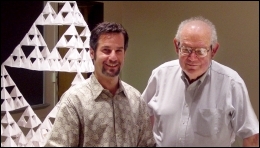Fractal Music
The term "fractal music" can mean different things to different people. Benoit Mandelbrot always had a strong intuition that music was measurably fractal. This is the sense in which we will use the term. Fractal geometry is, first and foremost, geometry, a subject whose name implies measurement. For music to be considered "fractal," it must possess some measurable property that qualifies it as such.
A quick Web search will reveal many misconceptions regarding what constitutes music that is truly fractal. Briefly stated, fractal music possesses at least one measurable, self-similar property (e.g., distribution of melodic intervals or note durations) that reflects an underlying power-law.
| |

|
| |
Harlan Brothers with Benoit Mandelbrot at Yale
[Click image to enlarge] |
During an informal discussion in 2003 regarding the apparent lack of clarity associated with the subject, the late Benoit Mandelbrot suggested to Harlan Brothers that he undertake a mathematically rigorous treatment of fractal music. The first result was a lecture and lab that Harlan presented at the 2004 Fractal Geometry Summer Workshop at Yale. He has subsequently published several papers on the subject. "Structural Scaling in Bach's Cello Suite No. 3," (Fractals Vol. 15, No. 1, 2007) reveals musical structure related to the Cantor set and helps to establish a mathematical foundation for the classification of fractal music. "Intervallic Scaling in the Bach Cello Suites," (Fractals Vol. 17, No. 4, 2009) describes a novel and robust approach to establishing the existence of power-laws in music.
His chapter entitled "The Nature of Fractal Music" appears in the memorial volume "Benoit Mandelbrot: A Life in Many Dimensions" (World Scientific Publishing, May 2015). He also produced a compilation of fractal music in honor of Benoit for Science Writers 2010, hosted at the Yale Peabody Museum. The program and dedication can be found here.
Harlan appears in Michael Lawrence's documentary, Bach & Friends where he discusses the work of Johann Sebastian Bach, mathematics, and fractal geometry. The film includes his zoom animation into the Mandelbrot set. Here is information regarding the fractal zoom. An article by Stephen Ornes about Harlan's research on fractal structure in the music Bach appears in the Proceedings of the National Academy of Sciences.
One of Harlan's early realizations was that musicians have been composing a form of fractal music for at least six centuries. Motivic scaling was familiar to many of the great Flemish composers such a Johannes Ockeghem and Josquin des Prez who developed the art of the mensuration or prolation canon. This type of canon is characterized by a melody or rhythmic motif that is repeated in different voices simultaneously at different tempos (here is an example). To be clear, not all mensuration canons are fractal; there are fundamental requirements that must be met in order to classify an object as such.
Modern composers, including Martin Bresnick, Conlon Nancarrow, and Arvo Pärt, have developed sophisticated compositional styles that often incorporate forms of motivic scaling. Many algorithmic artists also utilize this concept in their compositions. The Fractal Music Composer software, written for the Fractal Geometry Workshop, offers one the opportunity to experiment with composing fractal music in this time-honored style.
As with graphics, music can exhibit a wide variety of scaling behavior. In the course of exploring the role of power laws in music, Harlan has identified many types of scaling including, among others, self-similarity with respect to duration, pitch, interval, motif, and structure.
He has also written compositions to illustrate some of these scaling characteristics. The links below provide audio examples along with their descriptions (background information can be found here). While some of the compositions are too short to properly be considered fractal, they offer a hint of what one might listen for when searching for similar structure in the vast body of musical expression.
(Please note: Javascript and pop-ups must be enabled to listen to these compositions and read their descriptions. At the current time, Firefox appears to work best.)
| Combined Duration & Pitch Scaling: |
Here are some links to other work on the subject:

